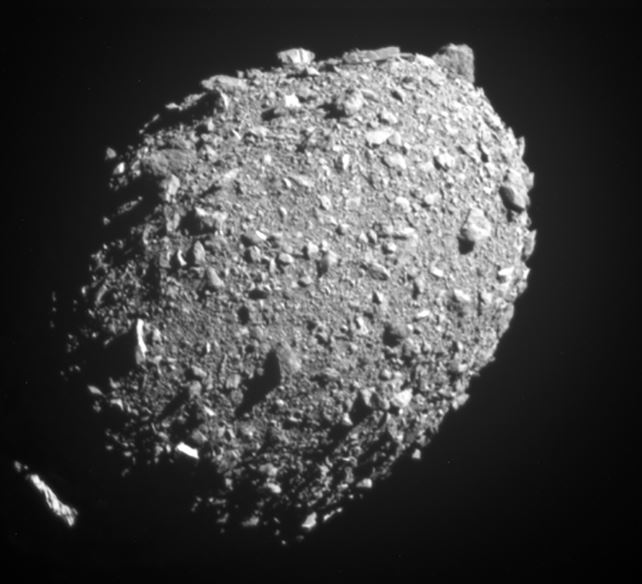
On September 26, a NASA spaceship (with no one on board) smashed into an asteroid—on purpose.
No, NASA wasn’t playing some kind of cosmic baseball game. They wanted to know if crashing into an asteroid would change its path or “orbit.”
Scientists had a theory that if they could hit an asteroid with an object travelling very fast, they could nudge the asteroid off the path it was on. So they came up with an experiment called the Double Asteroid Redirection Test, or DART.
Engineers built a box-shaped spacecraft that was about the size of a small car and weighed 570 kilograms. They put a special camera on the spacecraft and computers that would allow it to find and follow the asteroid they had selected for the experiment.
Asteroids are rocky objects that move around the sun. The smallest are the size of a large boulder. Some are up to 1,000 kilometers in diameter.
The asteroid that was the target for this mission is called Dimorphos. It is about 160 metres in diameter, or the size of football stadium. It orbits (goes around) another, larger asteroid, called Didymos. They are more than 7 million kilometres away from Earth.
The two asteroids go around the sun together, once every two years.
The DART spacecraft was launched in November 2021. It orbited the sun for 10 months, following the path of Didymos and Dimorphos. Most of that time, Dimorphos was hidden by the glare of sunlight reflecting off of the larger asteroid.
On September 26, the spacecraft’s camera spotted Dimorphos for the first time and its navigation system began to guide it through space towards its target. About an hour later, it crashed into Dimorphos at more than 22,500 kilometres per hour.
Scientists will study the data and images from the asteroids for the next few weeks to understand all of the effects the collision had on Dimorphos. That’s when they will know if their experiment worked.
They know that it usually takes Dimorphos 11 hours and 55 minutes to orbit Didymos. Scientists believe the collision should have moved Dimorphos closer to Didymos, and reduced the time it takes to orbit the larger asteroid by about seven minutes.
While this may seem like a very small change, it shows that—if a dangerous asteroid was heading toward us—it would be possible to knock it off its course, keeping Earth safe.
The chances of Earth actually being hit by an asteroid large enough to cause damage are extremely small. But NASA’s planetary defense program will ensure it never happens.
THINK & DISCUSS
- This article mentions many different “orbits.” Before you look up that word, what do you think it means? After you look it up: did it mean what you thought it meant? Was there anything in the article that suggested its meaning?
2. This article is about an asteroid. What is an asteroid? What is it made of?
3. DART is an “acronym” (pronounced like: ack-ro-nim). That is a short-form word made from the first letters of words in a phrase. In this case, DART = Double Asteroid Redirection Test (D-A-R-T). There is another acronym in this article: NASA. What does NASA stand for? What other acronyms do you know?
4. Earth is not in any danger from the asteroid. In fact, the two mentioned in the article are millions of kilometres away from Earth. Why, then, is NASA doing this experiment? Where does it say that in the article?
FUN FACT!
Scientists chose Dimorphos for this test because an important part of the experiment is measuring how much the asteroid moves from its usual course after it is hit by a spacecraft. It would be very difficult to measure the effect on a single asteroid’s orbit around the sun, but it is much easier to measure the change in Dimorphos’s orbit around Didymos.
LINKS
Spacecraft camera view of moments leading up to the impact
How will NASA know if it worked?
This website has asteroid facts for kids: https://nineplanets.org/kids/asteroid/







